Tips for Growing Blueberries Successfully
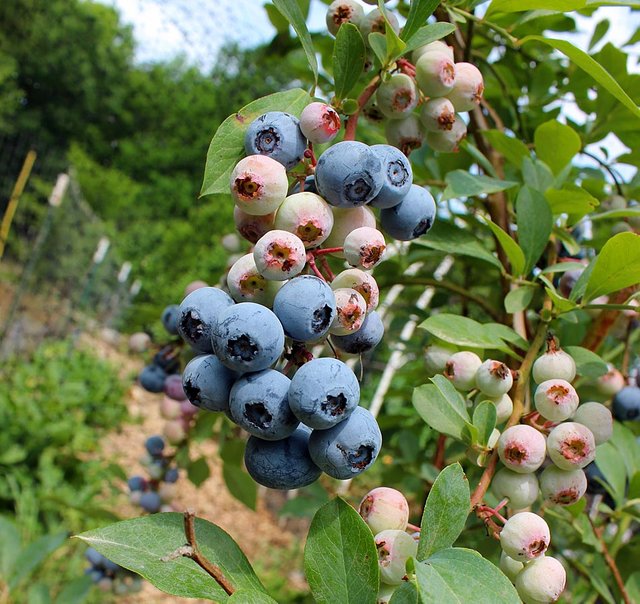

When people ask me what they should plant first in the garden, I always ask, "Do you like blueberries?" and if the answer is yes, I tell them to plant blueberry bushes first. Blueberries are not only delicious, they are full of antioxidants. Blueberry bushes have beautiful bright red fall colors making them lovely ornamental bushes in an edible landscape. And as a bonus, blueberry bushes are long lived perennials that can survive up to sixty years!
Important Factors to Growing Blueberry Successfully
The key to blueberry growing success is to pick the right cultivars for your climate.
The cultivars include Northern Highbush, Southern HighBush, Half-High Hybrids, and Rabbiteyes. I am in Southeastern Oklahoma with hot & humid summers and fairly mild winters, so I have the Rabbiteyes (Vaccinium Ashei) cultivar for my area.
It is also important to know blueberry bushes require other varieties of the same cultivar for cross pollination.
For example, I have Brightwell, Climax, Austin, Tiftblue, Premier & Powderblue blueberry bushes planted close to one another for cross pollination. These varieties are all in the Rabbiteyes cultivar.
In most cases when people say their blueberry bushes do not produce blueberries or produce poorly is because they are unaware that they need more than one variety of blueberry in the same cultivar in order to cross pollinate and produce abundant fruit.
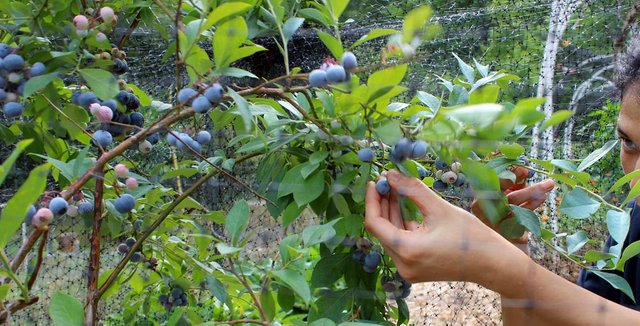
Blueberry planting Specifics
There are three basic requirements for growing healthy blueberry bushes.
- An acidic root zone (a PH between 4.8 and 5.5)
- Consistent moisture
- Lots of sunshine
Blueberry bushes have shallow roots located in the uppermost soil layer and they rarely reach beyond the dripline of the plant. This means blueberries rely on the grower to provide water in the root zone when there is a dry spell. Don't let a dry week go by without watering. They love to be mulched thickly. This will help keep consistent moisture for the root zone and reduce soil temperature.
Water is especially critical in the first year of a blueberry plant's life, so be sure to water your new plantings weekly if mother nature is not helping. The first year is very important for new blueberry bushes if you want healthy and long lived plants that will provide you with bountiful harvests all Summer long. Even though blueberries love moisture, it will not do well in a waterlogged location. So amend your planting holes accordingly if you have heavy clay content in your soil.
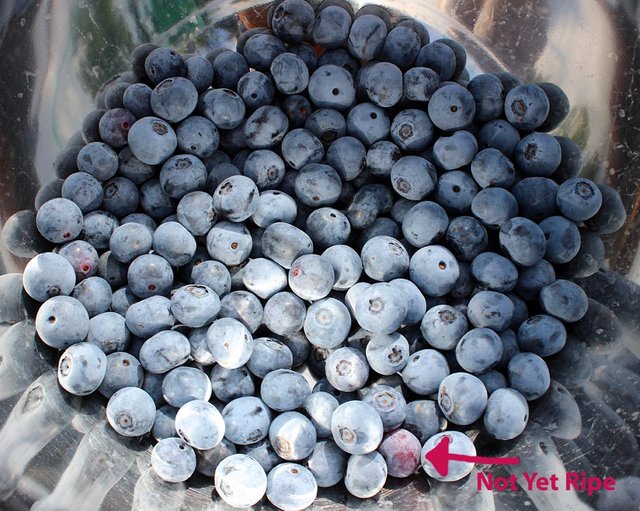
Long Harvest Season
The blueberry harvest season in our area usually starts in June and runs through mid July. Blueberries ripen over a long season and hold well on the bush, so you can wait to pick them as long as the blueberry bushes are protected from hungry birds. Different varieties of blueberry mature at different times, so planting more varieties will not only help with cross pollination, but it can also extend your blueberry harvest season.
Just because a blueberry has turned blue does not mean it's ripe!
It takes a few days after they turn blue to swell up and fully ripen. Ripe blueberries are plump. It hits the peak sweetness when you can run your fingers through the blueberry gently and it falls off easily into your hand. Remember berries do not continue to ripen once picked. If there is any hint of red color to the berry, it has not yet ripened to full maturity.
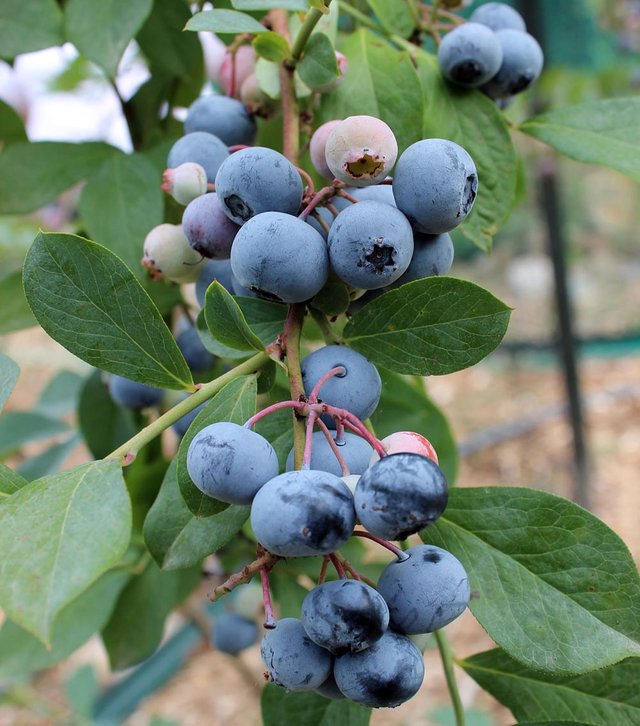
Watch the Birds
Birds are very fond of blueberries. They will steal all the blueberries on your bush if you don't have a way to deter them. We put up three different types of bird netting this year to see which one works better for our garden. My husband used T-posts and PVC for the frames and draped the bird netting over the frame, so we can harvest the blueberries inside the frames easily.
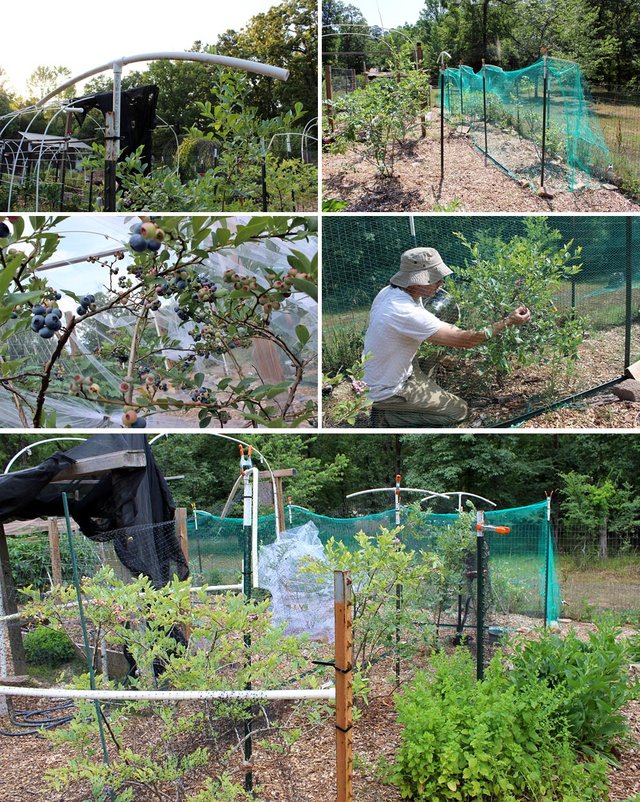
Early Producer
Blueberry bushes usually start producing berries in the second year. This is a whole lot earlier than fruit trees. If you are just starting to install a garden or planting an orchard, it's a good idea to include blueberries for early production. You can harvest blueberries throughout the Summer, while waiting for your young fruit trees to establish themselves and start producing fruit.
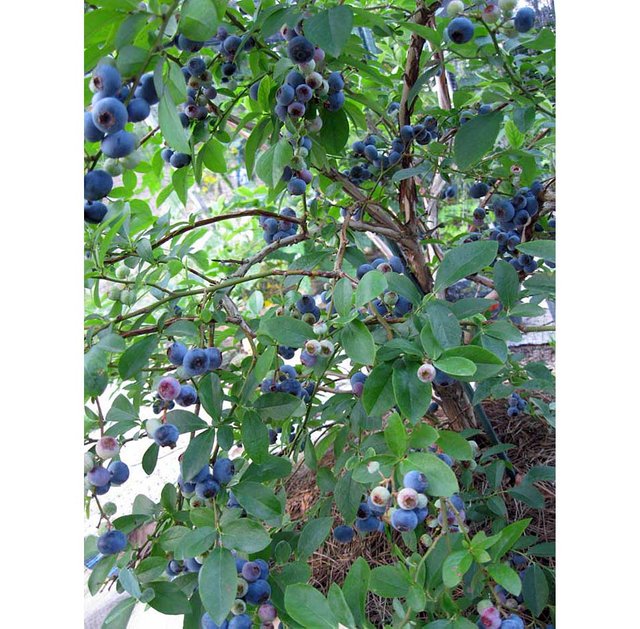
All photos come from my food forest
Photo copyright: @thelaundrylady
If you find my post helpful, please upvote, resteem and comment. I would love to hear from you.

I am honored to be an official passenger on the #ecotrain, a group of great people who are working hard to make this world a better place. Check out the previous ecoTrain magazines at @ecoTrain.

Your blueberries look delicious! I've been looking for some good information on growing them and this is perfect thank you so much for sharing. I'm actually going to reblog it so that I can refer back when I come to plant my own. 💖💖💖💖
Thank you. I am no expert, but I have gained quite a bit of experience from growing my own blueberry bushes for several years. I love blueberries, so I am always reading new research on growing blueberries. If you have any questions when you start to plant your own, you know where to find me :)
This is so beautiful! You have quite a set-up for growing, smart. I'm sure the birds would love to find a way in to those patches lol. Such a wonderful blessing! Great informative post by the way, thanks!
Thank you! I learned my lesson the first year when my blueberry bushes started producing. Let me just say that I was excited to harvest my blueberries for the first time then realized birds stole ALL of them. They didn't even leave one on the bush for me!
Oooo great info, should of guessed on having more than one for pollination perfect excuse to buy more then i think to go with my lonely blueberry plant 👍
The more varieties you have closed to one another, the more blueberries you will have on your bushes. I have a total of 18 blueberry bushes planted in my food forest. I believe I have six varieties. The funny thing is if you purchase blueberries from the store, they pretty much all taste alike. However, the ones I grow, have very distinctive difference in flavor, sweetness, and size. Love it when I have the excuse to purchase more plants :)
WOW, those are beautiful and plump. We would like to have them here too and look like that. It's really good for smoothies and maybe for artwork! Because they stain our hands when we hold them.
My mom asked you about chiggers because we have problems with them. And when she looked it up she said most chiggers like berry patches.
My dad and I take a really hot bath when we start itching really bad.
Thank you! As long as climate allows, I think blueberry bushes should be included in every garden or food forest. They look beautiful in the Fall, start producing berries in the second year, and is a super food. What more can one asks!
We must be in similar locations. We have lots of deer on our property, so ticks are found quite often. We also have lots of chiggers every Summer. I am no sure about the chigger and berry patch connections. I have no chiggers in my garden where the blueberry bushes are located. I only have chiggers outside of the garden where there are tall grasses or weeds. I think we just live in a climate where chiggers thrive.
I always rinse my legs off right after walking through some tall grasses and weeds. As long as I can rinse off within three hours, I have no issues usually. Those suckers can really make you itch!
Thank you for commenting, so I know to follow you. We have similar interest :)
You blueberries really producing a lot, does it grow in a tropical country with humid but hot weather?
Where are you located? The Rabbiteyes cultivar I have is a great choice for hot and humid Summers here in Oklahoma. It has lower chill hour for our milder Winters, but I am not sure about the tropical climate.
In Malaysia, very near the equator. Hot and occasion rainy season all year long.
Your blueberries are so healthy @thelaundrylady. I love blueberries but have no success in growing them. I'm sure it's the soils pH. I'll bookmark this and refer when I am can find plants again
Thank you. I seem to remember you are in South Africa. If the soil PH is too high, you can try adding lots of organic matter in the planting hole. Organic matter is naturally acidic. I doubt you can get your hands on peat moss or it would be helpful to add in the planting hole. Peat moss itself is acidic. You can also use sulfur, but I would use very little. Sulfur has fungicidal properties and can negatively affect soil biology if overused.
Thank you! My husband says he thinks he can get peat moss. We are wanting to make planter boxes on our enclosed porch. It's far more sheltered, under our immediate observation and has almost full day sun. I will be planting my more fragile herbs there. Do you think the blueberry would do there?
Hi thelaundrylady,
LEARN MORE: Join Curie on Discord chat and check the pinned notes (pushpin icon, upper right) for Curie Whitepaper, FAQ and most recent guidelines.
Ah, nice - I was thinking of growing blueberries, and I knew they were finicky, but now I know what it takes :)
It is a perennial, so less work for the gardener. Just a few simple things to remember, a little bit of your time and you will be rewarded with bountiful harvests all Summer long. Blueberry bushes are quite easy to care for. Just remember to water weekly :)
Last month I bought one and it's my first time that I will grow them. Didn't know that I need at least two plants. I guess nobody likes to be alone :)This info really helped and it came at the right time. Thank you...
So glad this post is helpful to you. I come across too many people planting just one blueberry bush or two of the same variety, so I had to include that info in the post. The more varieties you plant close to one another, the more blueberries you will have. Thanks for stopping by and commenting :)
Awesome post! Those blueberries sure do look yummy and juicy. We're in Green Country, what kind of cultivar should I be looking at? :D
Gosh, such beautiful food forest.
Do you have any problems with chiggers?
Chiggers you asked? Oh do we ever! Chiggers are a major problem here for sure.
Best to ask a local nursery you trust what cultivar to get. I am in the hot and humid part, so we only have the Rabbiteyes cultivar that will do well with low chilling hours here.